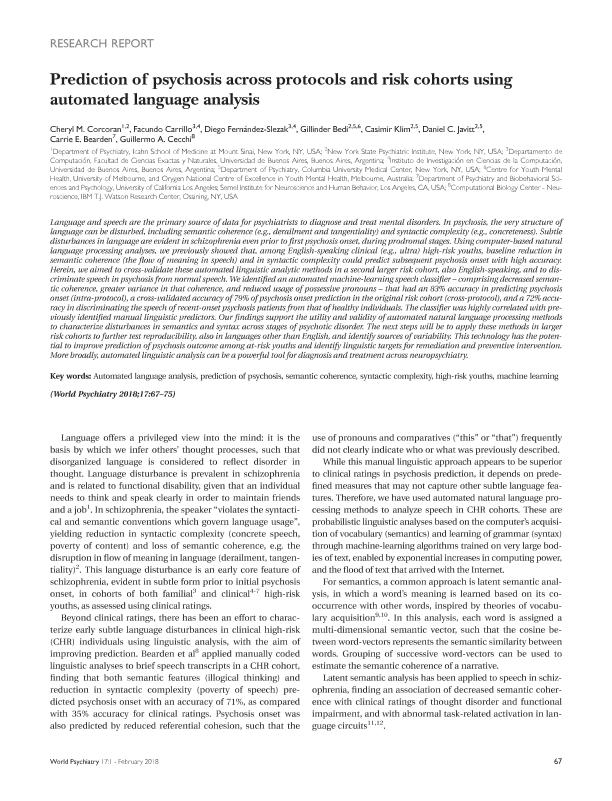Mostrar el registro sencillo del ítem
dc.contributor.author
Corcoran, Cheryl M.
dc.contributor.author
Carrillo, Facundo

dc.contributor.author
Fernandez Slezak, Diego

dc.contributor.author
Bedi, Gillinder
dc.contributor.author
Klim, Casimir
dc.contributor.author
Javitt, Daniel C.
dc.contributor.author
Bearden, Carrie E.
dc.contributor.author
Cecchi, Guillermo Alberto

dc.date.available
2020-02-10T15:30:06Z
dc.date.issued
2018-02
dc.identifier.citation
Corcoran, Cheryl M.; Carrillo, Facundo; Fernandez Slezak, Diego; Bedi, Gillinder; Klim, Casimir; et al.; Prediction of psychosis across protocols and risk cohorts using automated language analysis; Wiley; World Psychiatry; 17; 1; 2-2018; 67-75
dc.identifier.issn
1723-8617
dc.identifier.uri
http://hdl.handle.net/11336/97054
dc.description.abstract
Language and speech are the primary source of data for psychiatrists to diagnose and treat mental disorders. In psychosis, the very structure of language can be disturbed, including semantic coherence (e.g., derailment and tangentiality) and syntactic complexity (e.g., concreteness). Subtle disturbances in language are evident in schizophrenia even prior to first psychosis onset, during prodromal stages. Using computer-based natural language processing analyses, we previously showed that, among English-speaking clinical (e.g., ultra) high-risk youths, baseline reduction in semantic coherence (the flow of meaning in speech) and in syntactic complexity could predict subsequent psychosis onset with high accuracy. Herein, we aimed to cross-validate these automated linguistic analytic methods in a second larger risk cohort, also English-speaking, and to discriminate speech in psychosis from normal speech. We identified an automated machine-learning speech classifier – comprising decreased semantic coherence, greater variance in that coherence, and reduced usage of possessive pronouns – that had an 83% accuracy in predicting psychosis onset (intra-protocol), a cross-validated accuracy of 79% of psychosis onset prediction in the original risk cohort (cross-protocol), and a 72% accuracy in discriminating the speech of recent-onset psychosis patients from that of healthy individuals. The classifier was highly correlated with previously identified manual linguistic predictors. Our findings support the utility and validity of automated natural language processing methods to characterize disturbances in semantics and syntax across stages of psychotic disorder. The next steps will be to apply these methods in larger risk cohorts to further test reproducibility, also in languages other than English, and identify sources of variability. This technology has the potential to improve prediction of psychosis outcome among at-risk youths and identify linguistic targets for remediation and preventive intervention. More broadly, automated linguistic analysis can be a powerful tool for diagnosis and treatment across neuropsychiatry.
dc.format
application/pdf
dc.language.iso
eng
dc.publisher
Wiley

dc.rights
info:eu-repo/semantics/openAccess
dc.rights.uri
https://creativecommons.org/licenses/by-nc-sa/2.5/ar/
dc.subject
AUTOMATED LANGUAGE ANALYSIS
dc.subject
HIGH-RISK YOUTHS
dc.subject
MACHINE LEARNING
dc.subject
PREDICTION OF PSYCHOSIS
dc.subject
SEMANTIC COHERENCE
dc.subject
SYNTACTIC COMPLEXITY
dc.subject.classification
Ciencias de la Computación

dc.subject.classification
Ciencias de la Computación e Información

dc.subject.classification
CIENCIAS NATURALES Y EXACTAS

dc.subject.classification
Psiquiatría

dc.subject.classification
Medicina Clínica

dc.subject.classification
CIENCIAS MÉDICAS Y DE LA SALUD

dc.title
Prediction of psychosis across protocols and risk cohorts using automated language analysis
dc.type
info:eu-repo/semantics/article
dc.type
info:ar-repo/semantics/artículo
dc.type
info:eu-repo/semantics/publishedVersion
dc.date.updated
2019-12-16T19:13:25Z
dc.journal.volume
17
dc.journal.number
1
dc.journal.pagination
67-75
dc.journal.pais
Estados Unidos

dc.journal.ciudad
Hoboken
dc.description.fil
Fil: Corcoran, Cheryl M.. Icahn School of Medicine at Mount Sinai; Estados Unidos. New York State Psychiatric Institute; Estados Unidos
dc.description.fil
Fil: Carrillo, Facundo. Consejo Nacional de Investigaciones Científicas y Técnicas. Oficina de Coordinación Administrativa Ciudad Universitaria. Instituto de Investigación en Ciencias de la Computación. Universidad de Buenos Aires. Facultad de Ciencias Exactas y Naturales. Instituto de Investigación en Ciencias de la Computación; Argentina
dc.description.fil
Fil: Fernandez Slezak, Diego. Consejo Nacional de Investigaciones Científicas y Técnicas. Oficina de Coordinación Administrativa Ciudad Universitaria. Instituto de Investigación en Ciencias de la Computación. Universidad de Buenos Aires. Facultad de Ciencias Exactas y Naturales. Instituto de Investigación en Ciencias de la Computación; Argentina
dc.description.fil
Fil: Bedi, Gillinder. New York State Psychiatric Institute; Estados Unidos. Columbia University; Estados Unidos. University of Melbourne; Australia
dc.description.fil
Fil: Klim, Casimir. Columbia University; Estados Unidos. New York State Psychiatric Institute; Estados Unidos
dc.description.fil
Fil: Javitt, Daniel C.. Columbia University; Estados Unidos. New York State Psychiatric Institute; Estados Unidos
dc.description.fil
Fil: Bearden, Carrie E.. University of California at Los Angeles; Estados Unidos
dc.description.fil
Fil: Cecchi, Guillermo Alberto. IBM T.J. Watson Research Center; Estados Unidos
dc.journal.title
World Psychiatry

dc.relation.alternativeid
info:eu-repo/semantics/altIdentifier/doi/https://doi.org/10.1002/wps.20491
dc.relation.alternativeid
info:eu-repo/semantics/altIdentifier/url/https://onlinelibrary.wiley.com/doi/full/10.1002/wps.20491
dc.relation.alternativeid
info:eu-repo/semantics/altIdentifier/url/https://www.ncbi.nlm.nih.gov/pmc/articles/PMC5775133/
Archivos asociados
